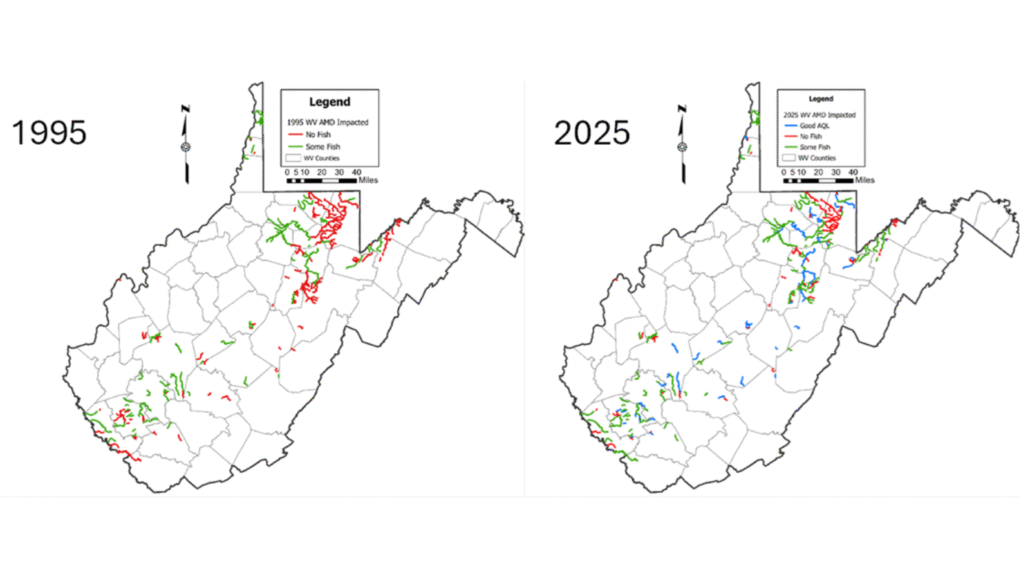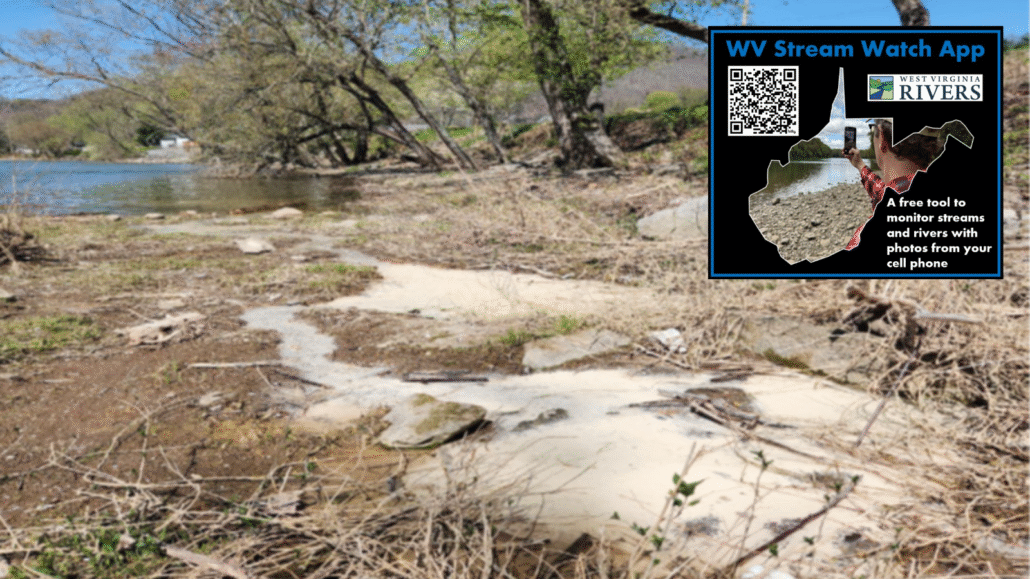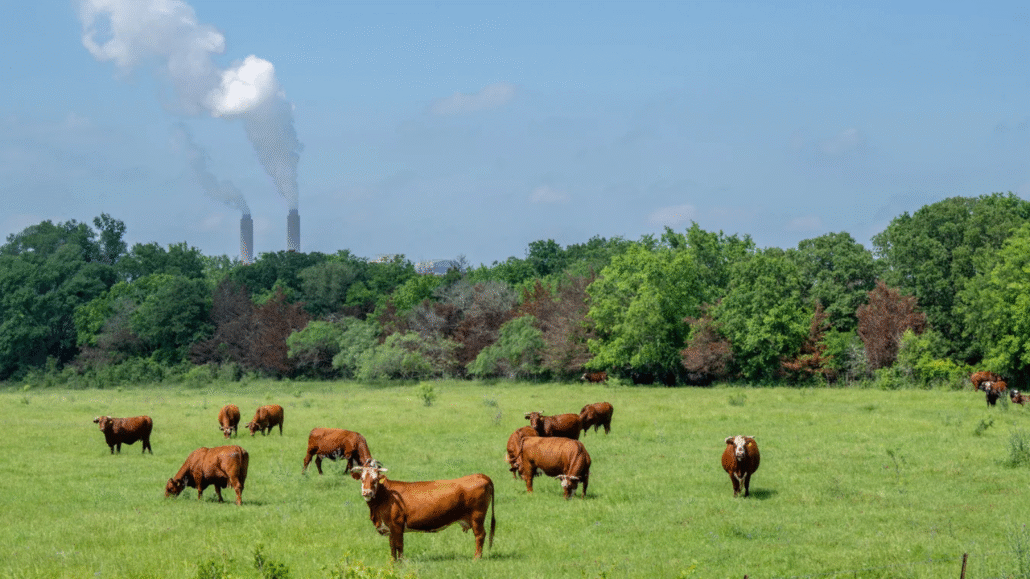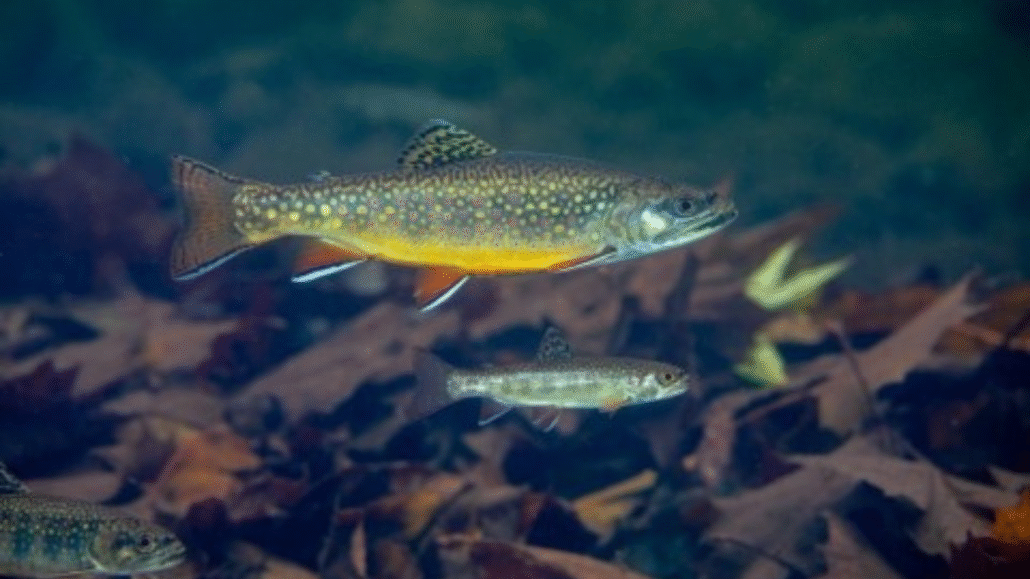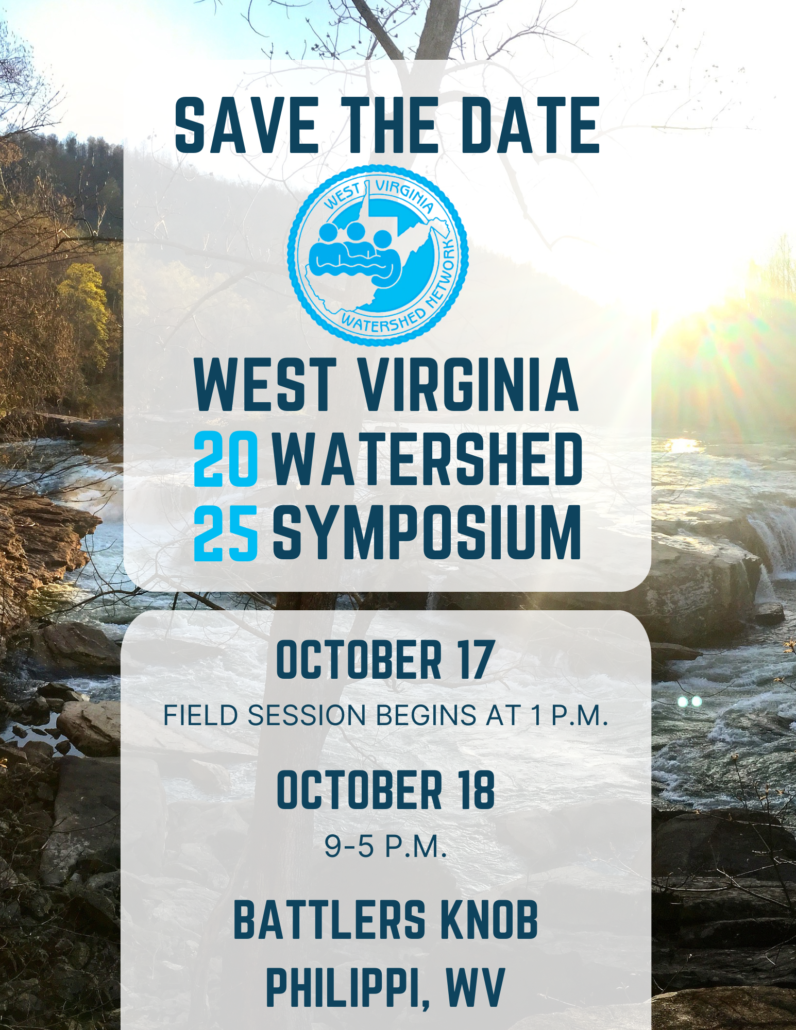Science News: Spring 2025 Edition
🔗 Want our Science Newsletter straight to your inbox? Sign up here: https://wvrivers.salsalabs.org/sciencenews
Blaise Hollot, a volunteer stream monitor with WV Rivers and Trout Unlimited, submitted this photo when documenting conditions along a stretch of Mill Run in Randolph County on May 27, 2025. As part of the WV-VA Water Quality Monitoring Project, Blaise recorded clear water, normal flow, and a water temperature of 52.5°F. Conductivity measured at 111.8 µS/cm — within the expected range for healthy Appalachian streams, indicating low levels of dissolved solids and minimal pollution.
What’s inside:
- Legislative Recap: A Win for Science and Public Health in WV
- Science Feature: Evidence for Stream Recovery from Acid Mine Drainage in WV
- WV Stream Watch App in Action: New River at Bellepoint
- Monitoring Update: New Team Forms in Wyoming County
- EPA Science Alert
- Campaign Update: Expanding WV Trout Waters
- What We’re Reading
- Ask a Scientist!
- Meet Daisy Fynewever: Georgetown University Intern
- Save the Date: 2025 WV Watershed Symposium
Legislative Recap: A Win for Science and Public Health in WV
Senior Scientist Than Hitt presents testimony to the WV House Committee on Health and Human Resources on March 18, 2025.
West Virginia’s 2025 legislative session considered many bills that affect water and public health, some bad and some good. But thanks to the involvement of scientists and residents from across the state, we have some good news to share: an extreme anti-science bill was stopped in its tracks. House Bill 2493 was deceptively named the “Sound Science in Regulations Act,” but in fact amounted to scientific censorship because it would have prohibited state agencies from using the best available scientific information to protect public health and the environment.
Here’s the testimony WV Rivers’ Senior Scientist, Than Hitt, provided to the WV House Committee on Health and Human Resources in opposition to this bill. The bill was sponsored by the US Chamber of Commerce, and notably, they also introduced this bill in the Tennessee legislature, where it was amended to remove some of the most draconian provisions, but nonetheless passed into law.
West Virginians should be proud that we rejected this anti-science legislation!
Science Feature: Evidence for Stream Recovery from Acid Mine Drainage in WV (But the Work is Not Done)
Biological recovery of some streams from acid mine drainage over 30 years. The category “some fish” refers to streams with depressed fish populations relative to expectations for healthy streams. In 2025, an additional category was added to indicate streams with “good aquatic life (AQL)” based on benthic macroinvertebrate community data. Take a closer look at these streams with an interactive map here.
We all need some good news every now and then. And fortunately for the attendees of the 43rd annual meeting of the WV Mine Drainage Task Force in Charleston this April, there was some good news to share: many streams across the Mountain State show evidence for fish population recovery from acid mine drainage (AMD) that has plagued the region for many decades.
The analysis was provided by Ben Faulkner, Task Force Chairman, based on data compiled from state fisheries biologists in 1995 and 2025. In both time periods, biologists classified streams as those with “no fish” and “some fish”, with the latter category indicating depressed populations relative to expectations for healthy streams. The original assessment from 1995 was part of the Strategic Plan for stream restoration from AMD produced by USEPA Region III and the Office of Surface Mining in collaboration with several other agencies and non-governmental organizations.
Results from the 1995 assessment were sobering: biologists in WV identified 1140 stream miles that were impaired due to AMD, of which 592 miles were considered to be fishless (with the caveat that small isolated populations may persist in springs or near stream confluences). Although impaired streams were identified from coal-bearing regions across the state, the Cheat and Tygart River basins showed the most concentrated impairments. But here’s the good part: 30 years later, biologists reported significant improvements, estimating 353 fewer miles of fishless streams in WV (60% less) than in the original assessment. Additional data from benthic macroinvertebrate community surveys and water quality samples further bolstered the conclusion that significant recovery has occurred since 1995.
The improvements demonstrate the success of investments in AMD treatment (e.g., hydrated lime dosers) as well as the hard work of scientists, government agencies, and watershed organizations, particularly Friends of the Cheat and Save the Tygart. However, the work is not done. Dosing stations must be funded and maintained, and additional efforts are needed to restore the 239 stream miles in WV currently considered to be fishless from AMD. New survey efforts are also needed to track the recovery of brook trout and other game fish and to document these economic and ecological benefits of AMD recovery.
The original presentation from the WV Mine Drainage Task Force Symposium is found on its web page here.
Monitoring Update: New Team Forms in Wyoming County
Senior Scientist Than Hitt addresses the community meeting in Pineville, WV on May 24.
The water crisis in Wyoming County has been in the news recently, and folks came together for a community meeting in Pineville to share their stories and concerns. The event was hosted by the Blue Feather Initiative, and WV Rivers staff attended to provide folks with tools they can use to understand pollution risks and monitor water quality. Unfortunately, Wyoming County has the highest number of water quality violations in the nation (see “what we’re reading” below), and community members shared many powerful stories about this crisis, as you can hear on the Appalachian Livin podcast. Several community members also stepped up to collect stream conductivity data – an important indicator of water quality and mine drainage. WV Rivers staff will be compiling and analyzing the monitoring results to share with the community and DEP. Stay tuned!
EPA Science Alert
Editor’s note: The following article was originally published in Scientific American on April 1, 2025, by Dr. Jennifer Sass. Dr. Sass is a Senior Scientist with the Natural Resources Defense Council and serves on the WV Rivers Coalition Board of Directors. It is reprinted here because Dr. Sass’ message is vital for the future of West Virginia and should be required reading for us all.
Cows graze near the Oak Grove Power Plant in Robertson County, Texas, subject to EPA (Environmental Protection Agency) rules to reduce carbon emissions and mercury pollution under the Biden administration. Brandon Bell/Getty Images, published in Scientific American on April 1, 2025
As Happened in Texas, Ignoring EPA Science Will Allow Pollution and Cancer to Fester
By Jennifer Sass
I’ve spent my scientific career asking the U.S. Environmental Protection Agency to set stronger, lawful public-health protections from toxic chemicals. I do not always agree with EPA’s final decisions, but I respect the scientific process and am always grateful for the agency’s scientists—our public brain trust.
In one of the most dangerous acts against facts and science, the Trump administration announced in March that it will shutter the EPA’s independent research office. This will cut more than 1,000 scientists and technical experts who help the agency determine if, for example, a chemical poses a cancer risk, or a factory is polluting a nearby river. At the same time, Trump’s EPA has installed former oil and chemical industry lobbyists to write the rules to regulate those industries.
There’s a lot of empty talk about making us healthy coming from this administration. Future generations will be even worse off.
What is left unsaid by the Trump EPA is this: eliminating scientists from the EPA is kneecapping environmental safeguards. Every major environmental statute—the Clean Air Act, the Safe Drinking Water Act and the Superfund law governing cleanup requirements—relies on EPA scientists to calculate how hazardous chemicals are, how people and wildlife may be exposed and what health and ecological harms may occur. Questions critical to environmental and community protections are researched, such as: Will exposure to this chemical in my workplace increase my risk of breast cancer? Is the air quality from power plant emissions safe for the neighboring community? What is an acceptable standard for PFAS forever chemicals in our drinking water?
Instead, the Trump team is yet again swinging its chainsaw, this time against independent science to favor polluting industries. Consequent to gutting scientific inquiries by the government and decimating academic scientific research, only one type of scientific research will be available for setting environmental standards: polluter research. And that’s trouble. The public is right to distrust polluter-sponsored science; see “tobacco science” and the myth of safe nuclear waste for starters.
Just ask Texas. The state of Texas’s vigorous defense of ethylene oxide, a well-known carcinogen, provides an ongoing example of the perils to public health from science done by a polluting industry with a financial interest in the outcome and the support of a state government hell-bent on rewriting scientific facts about a cancer-causing chemical.
In 2016, after nearly 10 years of research and analysis, the EPA determined ethylene oxide, a chemical widely used in facilities in Texas and Louisiana to sterilize medical equipment, was linked to cancer—with a 30 times greater risk than the EPA had previously found. EPA’s new risk evaluation included a study of over 300 breast cancer cases in women working with the chemical and adjusted for added risks where children may be exposed.
EPA’s report was finalized after multiple internal reviews, and reviews from other government agencies, with public input including from Texas and the industry on many occasions. There were also two rounds of public review by the agency’s science advisory board.
Rather than accept that finding, the chemical industry and Texas’ regulatory agency issued its own alternative report in 2020 on ethylene oxide. In stark contrast with EPA’s evaluation, the Texas assessment is a contractor product sponsored by the ethylene oxide industry with limited public review. It fails to account for the risk of breast cancer and could allow over 3,000 times more air pollution to be emitted, which would drastically increase illnesses and deaths—including from cancer—for workers and nearby communities.
In an effort to compel EPA to adopt Texas’ cancer-friendly risk estimates nationally, Texas requested a review of its findings by the U.S. National Academies of Sciences, Engineering, and Medicine, the nation’s top source of high-quality trusted science and health advice.
In March, the National Academies issued its final report, rebuking the foundations of the Texas analysis, finding it repeatedly deviated from best scientific practices and failed to offer a “credible basis” for its findings, specifically its determination that ethylene oxide was not associated with breast cancer.
Texas’ efforts to rewrite the history of cancer-causing ethylene oxide as a benign, no-big-deal chemical, is just the beginning of the toxic mayhem and misinformation we can expect from the Trump team to support the financial interests of toxic polluters.
Erasing cancer evidence, fudging data, and pretending wild claims are the truth will become the norm, undermining every environmental law and regulation in the nation, and compromising our right to health.
All of us will suffer for it.
Campaign Update: Expanding WV Trout Waters
Brook trout in a WV stream. Photo credit: Ryan Hagerty, US Fish and Wildlife Service
One of the designated uses for streams in WV is for trout fisheries – focusing of course on our spectacular state fish, the brook trout (Salvelinus fontinalis).
This designation is important not only for anglers but also because it strengthens water quality standards with downstream benefits for communities. WV Rivers is currently working with Trout Unlimited and other partners to expand the state’s official list of Trout Waters (also known as “B2” waters) by compiling new electrofishing data from WV Division of Natural Resources and working with the Department of Environmental Protection to protect these precious streams.
Stay tuned!
Ask a Scientist!
What science questions do you have about water issues in West Virginia? You can use this simple form to ask away!
WV Rivers staff will consult the literature and subject matter experts to find the answers, and we will follow up with you and will feature selected questions in future editions of Science News. Remember – there are no dumb questions (only those left unasked), so don’t be shy.
What We’re Reading: New Research on Appalachian Waters
Elakala Falls in Blackwater Falls State Park, captured by Brandon Hirt Photo.
- Mapping risks of water injustice and perceptions of privatized drinking water in the United States: A mixed methods approach
Access to safe drinking water is a human right, but water injustice abounds across WV and the nation. This study by Dr. Alex Segré Cohen, a professor at the University of Oregon, examined where water injustice hotspots are located across the nation, what may be causing them, and how people perceive them. The authors scored each county’s water injustice by combining a water violations score for public water systems with a social vulnerability score based on socioeconomic measures involving a community’s ability to afford an alternative water source. The results were revealing – and devastating – for West Virginia: water systems in southern WV, and in Wyoming County in particular, showed the highest rates of water quality violations across the entire nation.
Cohen, S.A., Slavik, C.E., Kurani, S., and J. Árvai. 2025. Mapping risks of water injustice and perceptions of privatized drinking water in the United States: a mixed methods approach. Risk Analysis 1–17. https://doi.org/10.1111/risa.70012
- Widespread microplastic pollution in central Appalachian streams
This study, published March 2025 in the journal Sustainability, was conducted by Isabella Tuzzio and colleagues at West Virginia University with the goal of investigating an unseen but omnipresent hazard in waters worldwide: microplastics. The team sampled 9 stream sites across north-central WV to collect fish for histological analysis of microplastics in their gastrointestinal system. They observed microplastics in all individuals, but the concentrations were not equal across the study area. The highest concentrations most particles were detected in the Cheat watershed (particularly at a site on Big Sandy Creek) followed by tributaries of the Monongahela and Ohio River. The results also suggested that agricultural land use and sewage inputs provide significant contributors to microplastic contamination in the region.
Tuzzio I.M., Murry B.A., and C.C. Arantes. 2025. Widespread microplastic pollution in central Appalachian streams: implications for freshwater ecosystem sustainability. Sustainability 17:2926. https://doi.org/10.3390/su17072926
- Drinking water sources, quality, and associated health outcomes in Appalachian Virginia: A risk characterization study in two counties
This paper was recently published in the International Journal of Hygiene and Environmental Health by Dr. Alasdair Cohen and co-authors to understand community exposure to waterborne pathogens in Appalachia. The researchers collected drinking water and saliva samples from 33 households in southwest Virginia and compared households on municipal water systems against those with private well water. The results were striking: they found that households on municipal water systems were much more safe than private wells. This finding is particularly important given that most prior research has focused on public water systems, and relatively little is known about private well water quality in Appalachia.
Cohen, A., et al. 2024. Drinking water sources, quality, and associated health outcomes in Appalachian Virginia: A risk characterization study in two counties. International Journal of Hygiene and Environmental Health 260:114390. https://doi.org/10.1016/j.ijheh.2024.114390
Meet Daisy Fynewever: 2025 WV Rivers Intern
Daisy Fynewever, Georgetown University
Daisy Fynewever is an undergraduate student majoring in Environmental Biology and Justice and Peace Studies at Georgetown University, and she has accepted a 2025 Internship with WV Rivers! Daisy will be conducting a study of water injustice in West Virginia to follow up on prior research by Dr. Alex Cohen (see above). She grew up in Michigan, where she witnessed the rivers and lakes of her hometown become more polluted over time, and she is passionate about doing the research to protect communities from water pollution. Through her backpacking trips, she fell in love with West Virginia and is excited to contribute to the work to protect it. Welcome Daisy!



